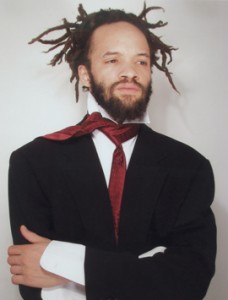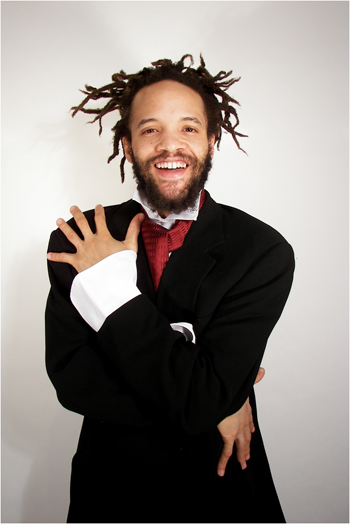CAUGHT IN A TAP
Savion Glover is easily one of the best tap dancers this country has ever produced, but to the adoring throng at the beautifully sleek and modern Valley Performing Arts Center, Glover is both an institution and the rock star of the tap world (where else would you see a concert where the feet are miked?); but don’t expect a tuxedo-clad man with top hat and cane gliding across a shiny floor to an Irving Berlin standard when you witness his virtuosic display. Ever since the wunderkind tap dancer made his Broadway debut at the age of 12 in The Tap Dance Kid, this indefatigable 38-year-old has come to define tap for a modern generation. Known especially for his Tony-winning choreography of Bring in ‘da Noise, Bring in ‘da Funk (1995), which ran on the Great White Way for 1135 performances, this hoofer came into being during the age of Stomp, a world-wide phenomenon that thrilled audiences with nothing more than the pounding clickety-clack of young athletic rhythmists using everyday objects.
 The tap work in Bare Soundz does not pretend to be sophisticated elegance, but a raw, almost primal display of a cappella pyrotechnic footwork; Glover, along with the adroit and personality-packed Marshall Davis, Jr. and, in her debut performance, Robyn Watson, perform as if their feet are sticks and the three elevated, square platforms they dance upon are drums. This unadorned performance proves that great tap dancing is caffeine for our soul. Glover directed the show using the pseudonym The HooFeRzCluB [sic], which is the name of his school for tap located in the hoofer’s birthplace of Newark, New Jersey. In Bare Soundz, 90 minutes of mostly original tap compositions, Glover is not interested in musical accompaniment; he is concentrating on tap as music itself – he wants us to listen to tap.
The tap work in Bare Soundz does not pretend to be sophisticated elegance, but a raw, almost primal display of a cappella pyrotechnic footwork; Glover, along with the adroit and personality-packed Marshall Davis, Jr. and, in her debut performance, Robyn Watson, perform as if their feet are sticks and the three elevated, square platforms they dance upon are drums. This unadorned performance proves that great tap dancing is caffeine for our soul. Glover directed the show using the pseudonym The HooFeRzCluB [sic], which is the name of his school for tap located in the hoofer’s birthplace of Newark, New Jersey. In Bare Soundz, 90 minutes of mostly original tap compositions, Glover is not interested in musical accompaniment; he is concentrating on tap as music itself – he wants us to listen to tap.
While many still hold tap as the Nicholas Brothers, Broadway-style buck and wing, the ballroom tap of Fred Astaire, or Gene Kelly’s balletic hoofing on rain-drenched cobblestone, I suspect that Glover sees a direct connection between tap and the African-American experience which gave rise to this distinctly American art form. During the early slave trade, slaveholders banned the use of native African instruments, fearing this form of communication would lead to revolt, but slaves were allowed to dance. Tap, as we know it today, evolved during the lampooning Minstrel Shows of the mid-1800’s and the classier Vaudeville duets, which in turn gave birth to the jazzier style of tap we see today, perfected by luminaries such as Glover’s mentor Gregory Hines. Glover, who also choreographed the animated Happy Feet, actively praises his mentors, teachers and past tap greats in the final segment of the night, but there is little on display that actually conjures these figures, except in the call-and-respond “improvography” of Mr. Hines. In this way, Glover is both venerator and iconoclast of the institution of tap.
Halfway through the routines – eleven in all – the audience rightfully whistled, hooted and consistently broke out into spontaneous applause. As Glover effortlessly executes the most demanding routines, it seems unfair that he is not even close to winded and the viewer is breathless. Although the large-framed Ms. Watson does not have an exciting persona, her footwork was equally astonishing. However, even the most exhilarating percussion-based shows can become wearying without variety, and the roar of the crowd lessened as the night wore on. Without more diversity of presentation, a spectator can feel tapped out. At one point, Mr. Glover sang “I Only Have Eyes For You” while his cohorts danced along, but there was no attempt to mix up the show with music, stagecraft or stories. Even the plot- and dialogue-free Irish spectacle Riverdance would be exhausting were it not for the non-dancing interludes. Bare Soundz certainly showcases the talent of Glover and Davis, but it left me longing for a celebration of the culture of tap, not just the remarkable proficiency of Savion Glover.
photos by Savion Glover Productions
Savion Glover’s Bare Soundz
Valley Performing Arts Center in Northridge (Los Angeles Theater)
played on March 24
for info on the Valley Arts Performing Arts Center season and tickets, visit http://www.ValleyPerformingArtsCenter.org

